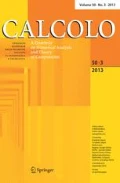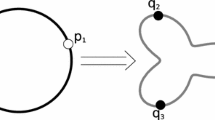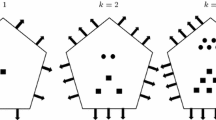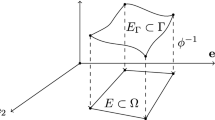Abstract
In this paper we consider the Virtual Element discretization of a minimal surface problem, a quasi-linear elliptic partial differential equation modeling the problem of minimizing the area of a surface subject to a prescribed boundary condition. We derive an optimal error estimate and present several numerical tests assessing the validity of the theoretical results.









Similar content being viewed by others
References
Beirão da Veiga, L., Ern, A.: Preface [Special issue—Polyhedral discretization for PDE]. ESAIM Math. Model. Numer. Anal. 50(3), 633–634 (2016). https://doi.org/10.1051/m2an/2016034
Beirão da Veiga, L., Brezzi, F., Cangiani, A., Manzini, G., Marini, L., Russo, A.: Basic principles of virtual element methods. Math. Models Methods Appl. Sci. 23(01), 199–214 (2013)
Antonietti, P.F., Beirão da Veiga, L., Scacchi, S., Verani, M.: A \({\cal{C}} ^1\) virtual element method for the Cahn–Hilliard equation with polygonal meshes. SIAM J. Numer. Anal. 54(1), 34–56 (2016)
Gatica, G.N., Munar, M., Sequeira, F.A.: A mixed virtual element method for a nonlinear Brinkman model of porous media flow. Calcolo 55(2), 21 (2018). https://doi.org/10.1007/s10092-018-0262-7
Cáceres, E., Gatica, G.N., Sequeira, F.A.: A mixed virtual element method for quasi-Newtonian Stokes flows. SIAM J. Numer. Anal. 56(1), 317–343 (2018). https://doi.org/10.1137/17M1121160
Beirão da Veiga, L., Lovadina, C., Vacca, G.: Virtual elements for the Navier–Stokes problem on polygonal meshes. SIAM J. Numer. Anal. 56(3), 1210–1242 (2018). https://doi.org/10.1137/17M1132811
Artioli, E., Beirão da Veiga, L., Lovadina, C., Sacco, E.: Arbitrary order 2D virtual elements for polygonal meshes: part II, inelastic problem. Comput. Mech. 60(4), 643–657 (2017). https://doi.org/10.1007/s00466-017-1429-9
Beirão da Veiga, L., Lovadina, C., Mora, D.: A virtual element method for elastic and inelastic problems on polytope meshes. Comput. Methods Appl. Mech. Eng. 295, 327–346 (2015). https://doi.org/10.1016/j.cma.2015.07.013
Cangiani, A., Chatzipantelidis, P., Diwan, G., Georgoulis, E.H.: Virtual element method for quasilinear elliptic problems. Tech. rep. arXiv:1707.01592 (2017)
Wang, F., Wei, H.: Virtual element methods for the obstacle problem. IMA J. Numer. Anal. (2018). https://doi.org/10.1093/imanum/dry055
Adak, D., Natarajan, S., Natarajan, E.: Virtual element method for semilinear elliptic problems on polygonal meshes. Appl. Numer. Math. 145, 175–187 (2019). https://doi.org/10.1016/j.apnum.2019.05.021
Adak, D., Natarajan, E., Kumar, S.: Virtual element method for semilinear hyperbolic problems on polygonal meshes. Int. J. Comput. Math. 96(5), 971–991 (2019). https://doi.org/10.1080/00207160.2018.1475651
Adak, D., Natarajan, E., Kumar, S.: Convergence analysis of virtual element methods for semilinear parabolic problems on polygonal meshes. Numer. Methods Partial Differ. Equ. 35(1), 222–245 (2019). https://doi.org/10.1002/num.22298
Liu, X., Chen, Z.: A virtual element method for the Cahn-Hilliard problem in mixed form. Appl. Math. Lett. 87, 115–124 (2019)
Ciarlet, P.G.: The Finite Element Method for Elliptic Problems. Studies in Mathematics and its Applications, vol. 4. North-Holland Publishing Co., Amsterdam-New York-Oxford (1978)
Beirão da Veiga, L., Lovadina, C., Russo, A.: Stability analysis for the virtual element method. Math. Models Methods Appl. Sci. 27(13), 2557–2594 (2017). https://doi.org/10.1142/S021820251750052X
Johnson, C., Thomée, V.: Error estimates for a finite element approximation of a minimal surface. Math. Comput. 29, 343–349 (1975). https://doi.org/10.2307/2005555
Talischi, C., Paulino, G., Pereira, A., Menezes, I.: Polymesher: a general-purpose mesh generator for polygonal elements written in Matlab. Struct. Multidiscip. Optim. 45(3), 309–328 (2012)
Kim, J., Chung, J.: Untangling polygonal and polyhedral meshes via mesh optimization. Eng. Comput. 31(3), 617–629 (2015). https://doi.org/10.1002/num.22298
Concus, P.: Numerical solution of the minimal surface equation. Math. Comput. 21, 340–350 (1967). https://doi.org/10.2307/2003235
Nitsche, J.C.C.: On new results in the theory of minimal surfaces. Bull. Am. Math. Soc. 71, 195–270 (1965). https://doi.org/10.1090/S0002-9904-1965-11276-9
Trasdahl, O., Ronquist, E.M.: High order numerical approximation of minimal surfaces. J. Comput. Phys. 230(12), 4795–4810 (2011). https://doi.org/10.1016/j.jcp.2011.03.003
Acknowledgements
The authors are members of the INdAM Research group GNCS and this work is partially funded by INDAM-GNCS. P.F.A. and M.V. acknowledge the financial support of MIUR thourgh the PRIN grant n. 201744KLJL.
Author information
Authors and Affiliations
Corresponding author
Additional information
Publisher's Note
Springer Nature remains neutral with regard to jurisdictional claims in published maps and institutional affiliations.
Rights and permissions
About this article
Cite this article
Antonietti, P.F., Bertoluzza, S., Prada, D. et al. The virtual element method for a minimal surface problem. Calcolo 57, 39 (2020). https://doi.org/10.1007/s10092-020-00388-0
Received:
Revised:
Accepted:
Published:
DOI: https://doi.org/10.1007/s10092-020-00388-0




